Related Research Articles
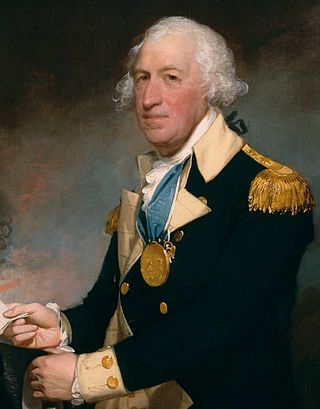
Horatio Lloyd Gates was a British-born American army officer who served as a general in the Continental Army during the early years of the Revolutionary War. He took credit for the American victory in the Battles of Saratoga (1777) – a matter of contemporary and historical controversy – and was blamed for the defeat at the Battle of Camden in 1780. Gates has been described as "one of the Revolution's most controversial military figures" because of his role in the Conway Cabal, which attempted to discredit and replace General George Washington; the battle at Saratoga; and his actions during and after his defeat at Camden.
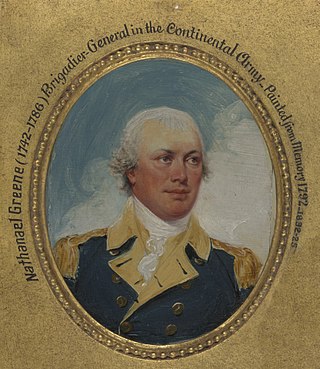
Major-General Nathanael Greene was an American military officer and planter who served in the Continental Army during the Revolutionary War. He emerged from the war with a reputation as one of George Washington's most talented and dependable officers, and is known for his successful command in the Southern theater of the conflict.
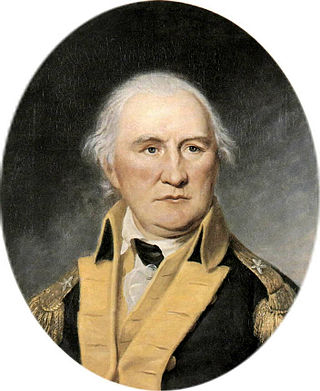
Daniel Morgan was an American pioneer, soldier, and politician from Virginia. One of the most respected battlefield tacticians of the American Revolutionary War of 1775–1783, he later commanded troops during the suppression of the Whiskey Rebellion of 1791–1794.
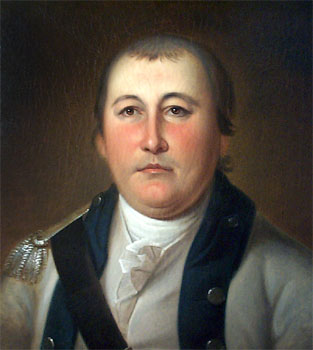
William Washington was a cavalry officer of the Continental Army during the American Revolutionary War, who held a final rank of brigadier general in the newly created United States after the war. Primarily known as a commander of light dragoons, he led mounted troops in a number of notable battles in the Carolinas during the campaigns of 1780 and 1781.

Thomas Nelson Jr. was a Founding Father of the United States, general in the Revolutionary War, member of the Continental Congress, and a Virginia planter. In addition to serving many terms in the Virginia General Assembly, he twice represented Virginia in the Congress, where he signed the Declaration of Independence in 1776. Fellow Virginia legislators elected him to serve as the commonwealth's governor in 1781, the same year he fought as a brigadier general in the siege of Yorktown, the final battle of the war.
William Pierce Jr. was a Founding Father of the United States, military officer during the Revolutionary War, member of the Continental Congress, merchant, and planter and slave owner. As a delegate representing Georgia at the Constitutional Convention of 1787, he left before he could sign the U.S. Constitution.
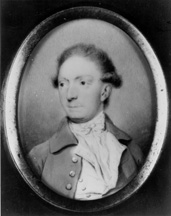
William Grayson was a planter, lawyer and statesman from Virginia. After leading a Virginia regiment in the Continental Army, Grayson served in the Virginia House of Delegates before becoming one of the first two U.S. Senators from Virginia, as well as a leader of the Anti-Federalist faction. Grayson became the first member of the United States Congress to die while holding office.

William Smallwood was an American planter, soldier and politician from Charles County, Maryland. He served in the American Revolutionary War, rising to the rank of major general. He was serving as the fourth Governor of Maryland when the state adopted the United States Constitution.
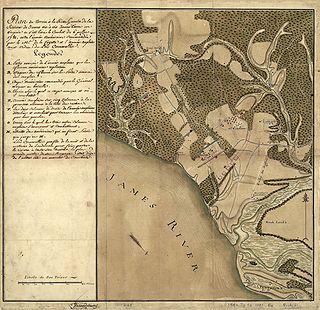
The Battle of Green Spring took place near Green Spring Plantation in James City County, Virginia during the American Revolutionary War. On July 6, 1781 United States Brigadier General "Mad" Anthony Wayne, leading the advance forces of the Marquis de Lafayette, was ambushed near the plantation by the British army of Earl Charles Cornwallis in the last major land battle of the Virginia campaign prior to the Siege of Yorktown.
William Woodford was a Virginia planter and militia officer who distinguished himself in the French and Indian War, and later became general of the 2nd Virginia Regiment in the American Revolutionary War, but was captured at the siege of Charleston, South Carolina and died of disease in New York City about six months later aboard a British prison ship.
The 8th Virginia Regiment or German Regiment was an infantry unit that served in the Continental Army during the American Revolutionary War. Authorized in January 1776, the regiment was raised from men of several northwestern counties in the strength of 10 companies. Its first commander was Colonel Peter Muhlenberg, a clergyman and militia leader. The unit marched to defend Charleston, South Carolina in 1776, but saw no fighting. At the start of 1777, the 8th Virginia moved to join George Washington's main army. When Muhlenberg was promoted to general officer, Colonel Abraham Bowman took command of the unit.

The Forage War was a partisan campaign consisting of numerous small skirmishes that took place in New Jersey during the American Revolutionary War between January and March 1777, following the battles of Trenton and Princeton. After both British and Continental Army troops entered their winter quarters in early January, Continental Army regulars and militia companies from New Jersey and Pennsylvania engaged in numerous scouting and harassing operations against the British and German troops quartered in New Jersey.
William Fitzhugh Gordon was a nineteenth-century, lawyer, military officer, politician and planter from the piedmont region of Virginia.
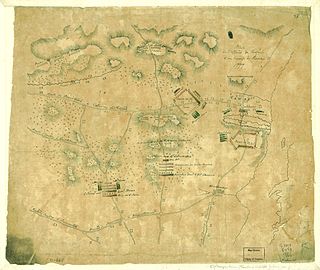
The Battle of the Short Hills was a conflict between a Continental Army force commanded by Brigadier General William Alexander, and an opposing British force commanded by Lieutenant General William Howe. The battle took place on June 26, 1777, at Scotch Plains and Edison, New Jersey, during the American Revolutionary War.

The Maryland and Virginia Rifle Regiment, most commonly known as Rawlings' Regiment in period documents, was organized in June 1776 as a specialized light infantry unit of riflemen in the Continental Army during the American Revolutionary War. The American rifle units complemented the predominant, musket-equipped, line infantry forces of the war with their long-range marksmanship capability and were typically deployed with the line infantry as forward skirmishers and flanking elements. Scouting, escort, and outpost duties were also routine. The rifle units' battle formation was not nearly as structured as that of the line infantry units, which employed short-range massed firing in ordered linear formations. The riflemen could therefore respond with more adaptability to changing battle conditions.
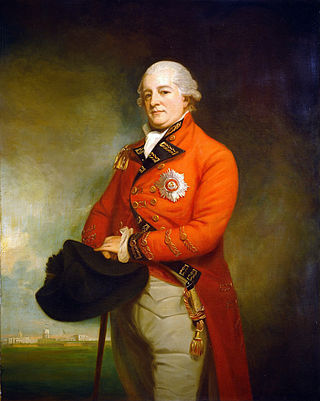
The Capture of Savannah, sometimes the First Battle of Savannah, or the Battle of Brewton Hill, was an American Revolutionary War battle fought on December 29, 1778 pitting local American Patriot militia and Continental Army units, holding the city, against a British invasion force, commanded by Lieutenant Colonel Archibald Campbell. The British capture of the city led to an extended occupation and was the opening move in the British southern strategy to regain control of the rebellious Southern provinces by appealing to the relatively strong Loyalist sentiment there.
Israel Shreve was a colonel in the 2nd New Jersey Regiment during the American Revolution. He fought at the Battle of Brandywine and at the Battle of Germantown and wintered at Valley Forge.

Brigadier-General John Hartwell Cocke II was an American military officer, planter and businessman. During the War of 1812, Cocke served in the Virginia militia. After his military service, he invested in the James River and Kanawha Canal and helped Thomas Jefferson establish the University of Virginia. The family estate that Cocke built at Bremo Plantation is now a National Historic Landmark.
The 4th Continental Artillery Regiment, also known as Reign’s Continental Artillery Regiment, was an American military unit during the American Revolutionary War. The regiment became part of the Continental Army on 10 June 1777 as Colonel Thomas Proctor's Continental Artillery Regiment. It was made up of eight artillery companies from eastern Pennsylvania. At the time of the regiment's formation, two companies were already in existence, one from as early as October 1775. One company served at Trenton in December 1776 where it performed well in action. In February 1777, Pennsylvania expanded its two-company battalion into an eight-company regiment. After officially joining the Continental Army, the regiment saw much fighting in the Philadelphia campaign in late 1777. Elements of Proctor's Regiment fought at Monmouth in June 1778 and joined the Sullivan Expedition in summer 1779.
Hartley's Additional Continental Regiment was an American infantry unit of the Continental Army that served for two years during the American Revolutionary War. The regiment was authorized in January 1777 and Thomas Hartley was appointed its commander. The unit comprised eight companies from Pennsylvania, Maryland, and Delaware. When permanent brigades were formed in May 1777, the regiment was transferred to the 1st Pennsylvania Brigade. Hartley's Regiment fought at Brandywine, Paoli, and Germantown in 1777. The unit helped defend the Pennsylvania frontier against indigenous raids in the Summer and early Fall of 1778. In January 1779, following a resolution of the Continental Congress the regiment, along with Patton's Additional Continental Regiment and part of Malcolm's Additional Continental Regiment, were combined to form a complete battalion known as the "New" 11th Pennsylvania Regiment. The 11th participated in the Sullivan Expedition in the summer of that year. In January 1781 the 11th merged with the 3rd Pennsylvania Regiment and ceased to exist.
References
- ↑ Daughters of the American Revolution, DAR Genealogical Research Databases, database online, (http://www.dar.org/ : accessed 28 Jun 2022), "Record of Thomas Massey", Ancestor # A075129
- ↑ Massie Family, Covington Virginian, Covington, Virginia, March 16, 1955. Reprinted by Gay Arritt, Historical Sketches of the Alleghany Highlands, The Alleghany Historical Society, Covington, Virginia, 1982, pgs. 77-79
- 1 2 3 "Pension Declaration of Major Thomas Massie". The Virginia Magazine of History and Biography. 21 (2): 184–192. 1913. JSTOR 4243264.
- 1 2 "Founders Online: From George Washington to Major Thomas Massie, 25 June 1779". founders.archives.gov.
- ↑ Lewis, Virgil Anson; Brock, Robert Alonzo (1996). Virginia and Virginians. ISBN 9780806346335.
- ↑ "Records of ante-bellum Southern plantations from the Revolution through the Civil War : Series G, Selections from the Barker Texas History Center, University of Texas at Austin and Selections from the Center for American History, University of Texas at Austin". FamilySearch. Retrieved 2023-04-08.
- ↑ "Pharsalia Plantation". SAH ARCHIPEDIA. October 29, 2019.